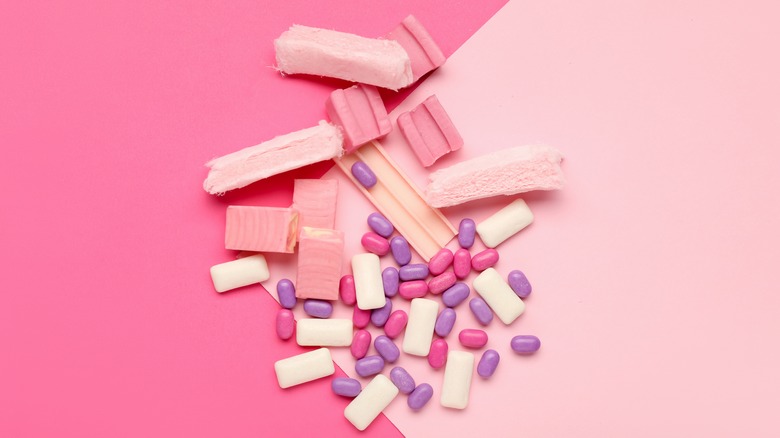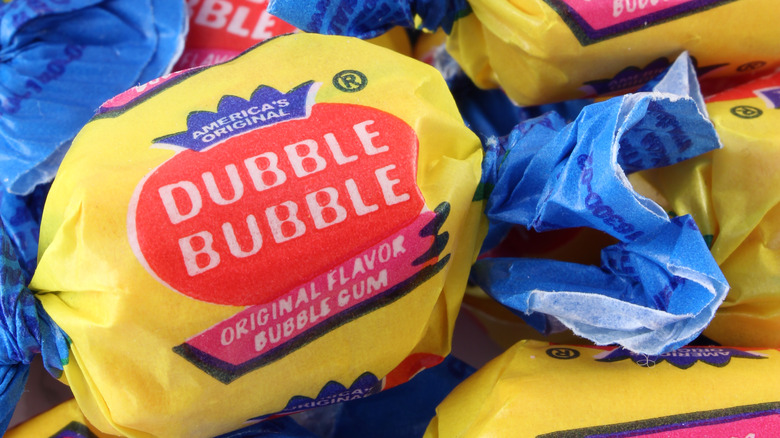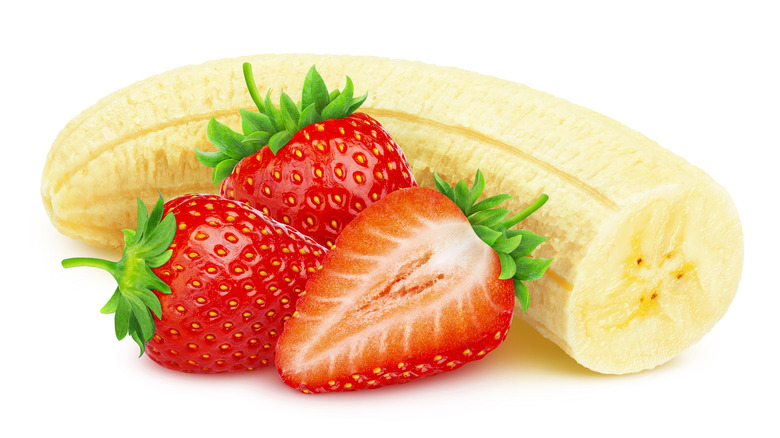What Is The Actual Flavor Of Bubblegum?
We've all tasted bubblegum, but do you actually know what bubblegum tastes like? Other types of gum try to emulate a natural flavor, like mint, fruit, or cinnamon (not to mention some truly weird gum flavors that are way outside the box), but not bubblegum. There's rarely a helpful image on bubblegum packaging, unlike the spearmint leaves, berries, or cinnamon sticks you see on other types. Instead, you see just pink bubbles, if anything at all. You can check the ingredients list on the pack, but it likely won't tell you that the gum contains anything more specific than "artificial flavor." What in the world are we chewing on?
It turns out that bubblegum is made with a mix of artificial fruit flavors, with strawberry and banana as the most frequent contributors. Other flavors in the mix could include cherry, orange, and lemon, as well as additional berry elements like raspberry and blueberry. Every company has its own unique recipe but, generally speaking, what you're tasting is going to be a sort of strawberry-banana punch. It is enigmatic and wholly original, which begs the question: who came up with bubblegum flavor in the first place?
Where did bubblegum flavor come from?
The commercial gum industry arose in the United States in the late 1800s, pioneered by New Yorker Thomas Adams. He had become infatuated with chicle, an early type of gum chewed by Mesoamerican people. Early on, gum manufacturers hit on the idea that blowing bubbles with their product would be fun, but nobody could get the formula quite right.
Frank Fleer, head of the Fleer Chewing Gum Company, was particularly interested in bubble gum, coming up with a product called Blibber Blubber in 1906. Unfortunately, proved too wet and sticky for blowing bubbles. Fleer abandoned the project, but in 1928, one of Fleer's accountants, a young man named Walter Diemer, dug up the old recipe and added latex to it. It worked perfectly, and Diemer recognized that it was perfect for the children's market. He figured a sweet, fruity taste would be most appealing to kids, so he mixed up the bubblegum flavor we know today (Diemer is also responsible for bubblegum's iconic pink color).
Diemer called his invention Dubble Bubble, and the flavor combination of his gum was not without precedent. Remember Thomas Adams? The first flavors of gum his company produced were black licorice and tutti frutti. The last variety combined numerous fruit flavors, including strawberry and banana, like the bubblegum flavor we know today.
How bubblegum flavor is made
Bubblegum isn't strictly a taste. Instead, it's really a smell. That's because we perceive flavor through two senses, taste and smell, the second of which is arguably more important. That's because our taste buds can only perceive a few flavors, but the olfactory receptors in our nose can perceive around one trillion different scents. So, when making artificial flavors, manufacturers target our noses rather than our tongues.
To achieve this goal, flavorists (a truly awesome job title) first identify the aromatic chemicals in natural foods and recreate them in a lab. You don't even need all of the compounds in a given food to simulate its flavor. For instance, oranges contain around 250 aromatic chemicals, but drink mix Tang only uses six to mimic the fruit's taste.
The flavorings used in bubblegum and other artificially-flavored foods mostly come from chemicals known as esters, which are made by combining different types of alcohols and acids to simulate natural aromas. The strawberry-banana flavor of bubblegum isn't actually made from strawberries and bananas, of course. Instead, it's typically a combination of ethyl methylphenylglycidate and pentyl acetate. Sounds delicious, doesn't it?


